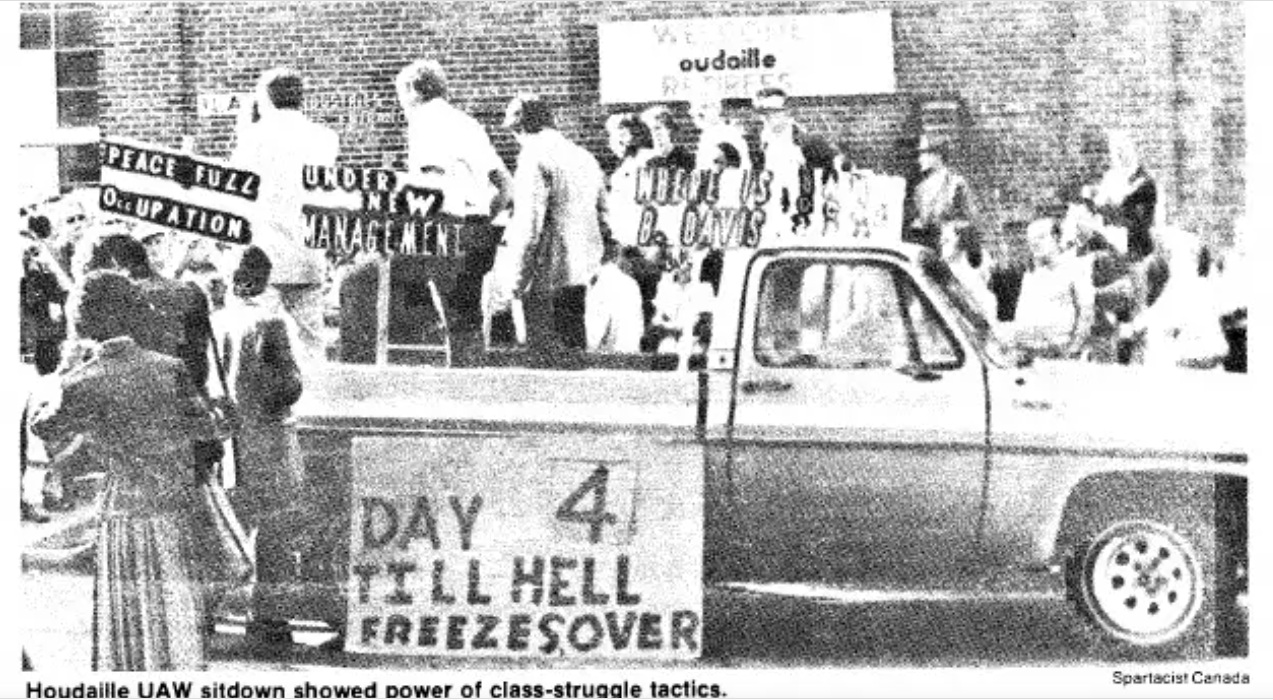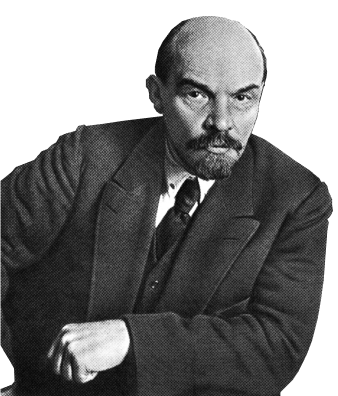
The U.S.-Canada trade war has placed a question mark over the future of tens of thousands of jobs in Canada. Perhaps none are more affected than Canada’s auto workers, thousands of whom have already been laid off—with more closures being threatened each day.
However, the response from union leaders has been tepid at best. The pleas for government intervention, including demands for counter-tariffs and production subsidies, have failed to stem the bleeding or give solace to the industry’s 135,000 workers.
But there are still more options on the table. In the past, workers resorted to occupying factories slated for closure in an attempt to save their jobs and defend their interests—often with positive results. This included Canada’s auto workers.
In the early 1980s, one factory after another was occupied in Ontario’s auto sector in response to planned closures and attacks on benefits. The most notable of these was the 1980 occupation of the Houdaille bumper plant in Oshawa—an event now largely forgotten to labour history.
In light of the situation facing workers today, this past needs revisiting.
Economic crisis
Ontario entered the 1980s facing a sharp economic crisis. The post-WWII economic boom had lost its steam, leaving many countries in the lurch. This was particularly true of manufacturing in the advanced capitalist countries.
Canada was more affected than most. In 1955, Canada was on par with the U.S. in terms of its manufacturing output per capita. By the end of 1974, Canada had been surpassed by Sweden, France, Japan, Finland, Australia and West Germany. The result was tens of thousands of manufacturing jobs lost in Canada during this period.
Canada’s auto sector was not immune from this process. In the first six months of 1980 alone, 15 auto parts plants were closed, leading to the elimination of over 6,000 jobs. This was made worse by the onset of a global recession in the early 1980s—a development which threatened even more jobs.
In the 1980s, Canadian workers facing layoffs had even fewer legal protections than exist today. Factories could be closed with little notice, while pensions and severance payouts were routinely given short shrift. This situation led to enormous pressure being placed by workers on their unions to do something.
The lead up to 1980s
The demand for factory occupations did not materialize all at once.
In the late 1970s, the U.S.-based chains and hoists manufacturer Columbus Mckinnon closed its plant in St. Catharines, Ontario, shifting production to the U.S. In response, the Canadian division of the United Auto Workers (UAW) launched a “buy-Canadian” campaign to persuade Columbus Mckinnon’s suppliers and clients to do its business elsewhere, preferably with companies based in Canada.
Though the UAW was successful in untethering some companies from Colombus Mckinnon, the plant was not reopened in St. Catharines—the union’s main demand. It became clear that other, more militant methods would be necessary to defend workers facing the sack.
The UAW started by presenting its demands on factory closures to the Ontario government. This included standard fare like protection of pensions, boosts for severance pay and payments to affected communities. However, the union also included a call for expropriation without compensation for any companies that shut operations and which failed to meet their other demands.
But workers didn’t wait for the government to act—indeed, it probably never had any plan to. In a 1980 meeting of Canadian UAW delegates in Port Elgin, Ontario, UAW leader Bob White took the podium to address the issue of factory closures. In a moment which White mentions in his memoirs was “off the cuff,” he told the assembled audience:
“If it takes occupations of plants to stop this, then we’ll occupy them.”
The delegates leapt to their feet and broke into cheer, in White’s recount. The idea of occupations had been given an enormous boost by UAW’s leadership. The wheels were set in motion.
The occupation begins
The response to White’s statement was immediate. The morning after the Port Elgin meeting, workers at the recently closed Bendix factory in Windsor climbed over the fence and took control of the facility for a six hour period.
This action was deemed premature by the UAW leadership, and White in particular. Despite that, the short but courageous act at Bendix led to workers being granted larger severance payouts than was initially offered. However, this action was soon eclipsed by events at Houdaille.
The U.S.-owned Houdaille bumper facility in Oshawa had never seen a strike since its establishment in 1948. Its 240 or so employees, many of them in their 50s, were looking forward to a good retirement after decades of loyalty and hard work.
However, those plans were dashed when Houdaille announced it was closing its doors by October 1980 and moving its equipment to South Carolina, an anti-union state. Furthermore, management planned to make deep cuts to workers’ pensions, while offering only a measly severance payout. This despite the fact that Houdaille had received a $600,000 federal grant just a few months prior, as well as having awarded its president a retirement payout of just over $1 million.
In August of 1980, the Houdaille workers held a meeting in their cafeteria and decided that an occupation of the plant was their only option. In the following days, about 200 of them marched into the facility and blockaded the gates in an orderly fashion. One of the 200 summed up the mood: “It’s ours so we took it!”
The occupiers set up for the long haul. On the front of the plant hung a sign reading “Till Hell Freezes Over,” with a counter tracking the number of days under occupation. They brought in sleeping bags, food, a television set, a dart board—all of the essentials. Guards were posted on the perimeters of the facility, fitted with walkie talkies. No equipment could be moved from the plant under their watch. The workers also had support from the outside, as their families and community members shuttled in necessary items when provisions ran low.
The occupiers even made efforts to trim the hedges and mow the lawn—depriving their opponents of any arguments for a crackdown. For the duration of the occupation, the plant was kept in pristine condition.
Spreading the movement
The occupation of the plant was carried out in full knowledge of its illegality. The Houdaille workers counted on the support of their union, the UAW, to help them soldier on. Fortunately, the union had their back. The Houdaille occupation became the first illegal job action in UAW history to receive strike pay. In response to concerns about potential legal action from UAW’s central leadership, Bob White remembers telling them at the time: “We can’t worry about lawsuits right now.”
The UAW also played a role in organizing large rallies outside of the plant, including family of the occupiers and other workers in Oshawa. During one of those rallies, White decided to up the ante:
“In case anyone is thinking about trying to break up the sit-in, I want to make it clear that we have 14,000 UAW members in the General Motors plants in this city, and we’ll empty those plants if need be. If someone tries to force these Houdaille workers out of here, those 14,000 workers will come over in waves.”
It could be disputed whether or not White actually meant to carry out his threat. In any case, workers at plants outside of Oshawa were already staging their own occupations on the model of Houdaille—making it no abstract proposal. The threat of contagion was a real one.
In the summer of 1980, workers occupied the Beach Foundry facility in Ottawa without the prior approval of their union—though they received it after the fact. During the same period, United Electrical Workers occupied the Tung-Sol factory in Bramalea. In both cases, the workers won large increases to their severance payouts—in the case of Tung-Sol, a six-fold increase from the original offer.
The promise of escalation by union leaders like White helped to lift workers’ confidence even higher. It also struck fear into the hearts of Ontario’s auto bosses. This combination of factors helped pave the way for a win at Houdaille.
On August 21, the Houdaille occupation ended after accepting a new offer by a vote of 177 to 14. The action had lasted two weeks and held firm for that entire time. The offer restored the right to retire early for 38 workers who were at risk of losing it—one of the main demands of the occupation. The offer also enhanced the severance payout for all workers by up to a factor six from the original offer.
However, the actions taken at Houdaille and other plants in 1980 also scored a broader victory. The threat of an even larger factory occupations movement compelled the Ontario Conservative government of William Davis to introduce legislation that bolstered severance pay for all workers affected by plant closures, making Ontario only the second jurisdiction in Canada to do so. One Houdaille worker is recorded as saying “We may not succeed, but maybe what we’re doing will help other workers.” In fact, they accomplished both.
Lessons
The lessons of Houdaille hold more value than ever today. In particular, it demonstrated the value of factory occupations in defending workers faced with plant closures and the methods by which to conduct them.
Today’s union leaders have largely spurned the idea of factory occupations, focusing instead on measures like production subsidies and “Buy Canadian” policies. However, these measures have been tried before to no avail. Houdaille proved the superiority of militant methods in defending workers—not in theory, but in practice.
Houdaille also shows the role that bold union leadership plays in building confidence among workers. Bob White’s endorsement of factory occupations at Port Elgin gave a mighty push and direction to thousands of workers who were chomping at the bit to take action. The ongoing support of UAW helped to bolster workers’ courage and deepen the movement at each stage. This element is sorely lacking in our trade union leadership today.
Finally, Houdaille demonstrated that the way to make a movement strong is to spread it as wide as possible. The Houdaille workers did not secure victory on their own—brave though they were. This came only through the organized involvement of the wider community, and the threat of UAW to bring other workers into the fray. The resulting change to Ontario law was a victory that benefited the entire working class. This is the real meaning of the slogan “a victory for one is a victory for all.”
The history of Houdaille has been largely forgotten—as have many of its lessons. However, learning them is an essential first step in preparing workers for the crisis of today.

